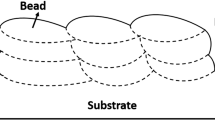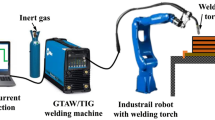Abstract
Micro-plasma transfer arc metal additive manufacturing (μ-PTAMAM) process is a unique direct energy deposition (DED) type additive manufacturing (AM) process capable of manufacturing three-dimensional metallic components through simultaneous use of wire and powder forms of AM material. DED process yields an uneven surface on the manufactured components which necessitates their further post-processing to attain the required surface finish, dimensional accuracy, and geometrical accuracy. This research focuses on using machine learning algorithm, namely, K-nearest neighbors (KNN), to predict the surface roughness. The data of surface roughness for training KNN algorithm was generated by depositing multi-layer single-track depositions yielding wall-like structures using Stellite-6 as AM material in powder and wire forms. It was found that surface roughness increases with an increase in power supply to micro-plasma and AM material feed rate whereas it decreases with an increase in traverse speed of the deposition head for both powder and wire of the AM material. Surface roughness of the walls for powder form of the AM material is smaller (i.e., 118 to 149 μm) than that obtained by the wire form (i.e., 195 to 227 μm). Surface roughness prediction error for KNN algorithm is found to be from − 6.2 to 2.8% for powder form and − 5.8 to 2.3% for wire form of the AM material proving capability of KNN algorithm for accurate prediction of surface roughness produced by μ-PTAMAM process. Since the prediction error depends on number of data set used to train KNN algorithm, therefore, it can be further reduced by increasing number of training data set.










Similar content being viewed by others
Availability of data and material
Authors understand that our manuscript and associated personal data will be shared with Research Square for the delivery of the author dashboard.
Code availability
No software has been developed in this manuscript.
References
Nikam SH, Jain NK (2018) 3D-finite element simulation and image processing based prediction of width and height of single-layer deposition by micro-plasma-transferred arc process. Int J Adv Manuf Technol 95:3679–3691. https://doi.org/10.1007/s00170-017-1472-x
Kumar P, Jain NK, Sawant MS (2020) Modelling of dimensions and investigations on geometrical deviations of metallic components manufactured by μ-plasma transferred arc additive manufacturing process. Int J Adv Manuf Technol 107:3155–3168. https://doi.org/10.1007/s00170-020-05218-9
Abe T, Mori D, Sonoya K, Nakamura M, Sasahara H (2019) Control of the chemical composition distribution in deposited metal by wire and arc-based additive manufacturing. Prec Eng 55:231–239. https://doi.org/10.1016/j.precisioneng.2018.09.010
Busachi A, Erkoyuncu J, Colegrove P, Martina F, Watts C, Drake R (2017) A review of additive manufacturing technology and cost estimation techniques for the defence sector. CIRP J Manuf Sci Technol 19:117–128. https://doi.org/10.1016/j.cirpj.2017.07.001
Chen X, Kong F, Fu Y, Zhao X, Li R, Wang G, Zhang H (2021) A review on wire-arc additive manufacturing: typical defects, detection approaches, and multisensor data fusion-based model. Int J Adv Manuf Technol 1–21. https://doi.org/10.1007/s00170-021-07807-8
Lewandowski JJ, Seifi M (2016) Metal additive manufacturing: a review of mechanical properties. Ann Rev of Mater Res 46:151–186. https://doi.org/10.1146/annurev-matsci-070115-032024
Thivillon L, Bertrand P, Laget B, Smurov I (2009) Potential of direct metal deposition technology for manufacturing thick functionally graded coatings and parts for reactors components. J Nucl Mater 385:236–241. https://doi.org/10.1016/j.jnucmat.2008.11.023
Taminger KM, Hafley RA (2006) Electron beam freeform fabrication for cost effective near-net shape manufacturing, NATO unclassified document. https://ntrs.nasa.gov/api/citations/20080013538/downloads/20080013538.pdf. Accessed 4 Mar 2017
Sciaky (2017) Metal additive manufacturing 3D printing. http://www.sciaky.com/images/pdfs/product-sheets/Sciaky-EBAM-Systems.pdf. Accessed 19 Mar 2021
Lin J, Lv Y, Liu Y, Xu B, Sun Z, Li Z, Wu Y (2016) Microstructural evolution and mechanical properties of Ti-6Al-4V wall deposited by pulsed plasma arc additive manufacturing. Mater Des 102:30–40. https://doi.org/10.1016/j.matdes.2016.04.018
Williams SW, Martina F, Addison AC, Ding J, Pardal G, Colegrove P (2016) Wire + arc additive manufacturing. Mater Sci Technol 32:641–647. https://doi.org/10.1179/1743284715Y.0000000073
Abe T, Sasahara H (2016) Dissimilar metal deposition with a stainless steel and nickel-based alloy using wire and arc-based additive manufacturing. Prec Eng 45:387–395. https://doi.org/10.1016/j.precisioneng.2016.03.016
Xiong X, Zhang H, Wang G (2009) Metal direct prototyping by using hybrid plasma deposition and milling. J Mater Process Technol 209:124–130. https://doi.org/10.1016/j.jmatprotec.2008.01.059
Tan KL, Yeo SH (2017) Surface modification of additive manufactured components by ultrasonic cavitation abrasive finishing. Wear 378:90–95. https://doi.org/10.1016/j.wear.2017.02.030
Zhu XP, Lei MK, Ma TC (2003) Surface morphology of titanium irradiated by high-intensity pulsed ion beam. Nucl Instrum Methods Phys Res Sect B 211:69–79. https://doi.org/10.1016/S0168-583X(03)01124-8
Chernovol N, Sharma A, Tjahjowidodo T, Lauwers B, Van Rymenant P (2021) Machinability of wire and arc additive manufactured components. CIRP J Manuf Sci Technol 35:379–389. https://doi.org/10.1016/j.cirpj.2021.06.022
Gharbi M, Peyre P, Gorny C, Carin M, Morville S, Le Masson P, Carron D, Fabbro R (2013) Influence of various process conditions on surface finishes induced by the direct metal deposition laser technique on Ti–6Al–4V alloy. J Mater Process Technol 213:791–800. https://doi.org/10.1016/j.jmatprotec.2012.11.015
Xiong J, Zhang G, Gao H, Wu L (2013) Modeling of bead section profile and overlapping beads with experimental validation for robotic GMAW-based rapid manufacturing. Rob Comp Integ Manuf 29:417–423. https://doi.org/10.1016/j.rcim.2012.09.011
Liu J, Li L (2004) In-time motion adjustment in laser cladding manufacturing process for improving dimensional accuracy and surface finish of the formed part. Opt Laser Technol 36:477–483. https://doi.org/10.1016/j.optlastec.2003.12.003
Xiong J, Li Y, Li R, Yin Z (2018) Influences of process parameters on surface roughness of multi-layer single-pass thin-walled parts in GMAW-based additive manufacturing. J Mater Process Technol 252:128–136. https://doi.org/10.1016/j.jmatprotec.2017.09.020
Ding D, Pan Z, Cuiuri D, Li H (2015) A multi-bead overlapping model for robotic wire and arc additive manufacturing (WAAM). Rob Comp Integ Manuf 31:101–110. https://doi.org/10.1016/j.rcim.2014.08.008
Suryakumar S, Karunakaran KP, Bernard A, Chandrasekhar U, Raghavender N, Sharma D (2011) Weld bead modelling and process optimization in hybrid layered manufacturing. Comp Aided Des 43:331–344. https://doi.org/10.1016/j.cad.2011.01.006
Jhavar S, Jain NK, Paul CP (2014) Enhancement of deposition quality in micro-plasma transferred arc deposition process. Mater Manuf Process 29:1017–1023. https://doi.org/10.1080/10426914.2014.892984
Hu Z, Qin X, Li Y, Yuan J, Wu Q (2019) Multi-bead overlapping model with varying cross-section profile for robotic GMAW-based additive manufacturing. J Intell Manuf 1–5. https://doi.org/10.1007/s10845-019-01501-z
Caiazzo F, Caggiano A (2018) Laser direct metal deposition of 2024 Al alloy: trace geometry prediction via machine learning. Materials 11:444. https://doi.org/10.3390/ma11030444
Khanzadeh M, Chowdhury S, Tschopp MA, Doude HR, Marufuzzaman M, Bian L (2019) In-situ monitoring of melt pool images for porosity prediction in directed energy deposition processes. IISE Trans 51:437–455. https://doi.org/10.1080/24725854.2017.1417656
Zhang Z, Liu Z, Wu D (2021) Prediction of melt pool temperature in directed energy deposition using machine learning. Add Manuf 37:101692. https://doi.org/10.1016/j.addma.2020.101692
Mozaffar M, Paul A, Al-Bahrani R, Wolff S, Choudhary A, Agrawal A, Cao J (2018) Data-driven prediction of the high-dimensional thermal history in directed energy deposition processes via recurrent neural networks. Manuf letters 18:35–39. https://doi.org/10.1016/j.mfglet.2018.10.002
Li J, Sage M, Guan X, Brochu M, Zhao YF (2020) Machine learning-enabled competitive grain growth behaviour study in directed energy deposition fabricated Ti6Al4V. JOM 72:458–464. https://doi.org/10.1007/s11837-019-03917-7
Xia C, Pan Z, Polden J, Li H, Xu Y, Chen S (2021) Modelling and prediction of surface roughness in wire arc additive manufacturing using machine learning. J Intell Manuf 1–16. https://doi.org/10.1007/s10845-020-01725-4
Song D, Chung Baek AM, Koo J, Busogi M, Kim N (2020) Forecasting warping deformation using multivariate thermal time series and K-nearest neighbors in fused deposition modeling. Appl Sci 10:8951. https://doi.org/10.3390/app10248951
Kumar P, Jain NK (2020) Effect of material form on deposition characteristics in micro-plasma transferred arc additive manufacturing process. CIRP J Manuf Sci Technol 30:195–205. https://doi.org/10.1016/j.cirpj.2020.05.008
Author information
Authors and Affiliations
Corresponding author
Ethics declarations
Consent for publication
All the authors have given their consent for publication of this manuscript.
Conflict of interest
The authors declare no competing interests.
Additional information
Publisher's note
Springer Nature remains neutral with regard to jurisdictional claims in published maps and institutional affiliations.
Rights and permissions
About this article
Cite this article
Kumar, P., Jain, N.K. Surface roughness prediction in micro-plasma transferred arc metal additive manufacturing process using K-nearest neighbors algorithm. Int J Adv Manuf Technol 119, 2985–2997 (2022). https://doi.org/10.1007/s00170-021-08639-2
Received:
Accepted:
Published:
Issue Date:
DOI: https://doi.org/10.1007/s00170-021-08639-2




